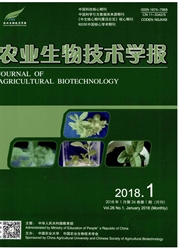

 中文摘要:
中文摘要:
为了降低细菌在处理重金属中的成本以及增加实际应用的可能性,本实验使用豆腐废水作为微生物的廉价培养基,并将培养好的微生物应用于实际电镀废水中铬、镍等重金属的去除.研究发现蜡状芽胞杆菌(Bacillus cereus)和人苍白杆菌(Ochrobactrum anthropi)在稀释的豆腐废水中就能很好的生长,表明豆腐水能够提供细菌生长的必需营养物质.此外,在添加了糖渣浸出液的豆腐废水且pH值为7.5时为细菌的最适宜生长条件.进一步的研究则表明在最佳条件下分别生长的蜡状芽胞杆菌和人苍白杆菌,对初始浓度分别为214和367 mg/L的含铬、镍的电镀废水均具有较好的去除效率,并且细菌的菌量越大去除效率越高,去除效率可以达到80%以上.对处理前后的蜡状芽胞杆菌进行显微成像观察(原子力显微镜、扫描电镜和透射电镜),结果发现电镀废水对细菌的形貌破坏较为严重,同时X-射线能谱分析(EDS)表明胞内和胞外都参与了铬和镍的固定.此外,傅里叶变换红外光谱(fourier transform infrared,FT-IR)的数据暗示着细菌的N-H和C=O等官能团在重金属的固定过程中发挥了重要的作用.本研究通过使用豆腐废水用于廉价培养细菌,为细菌治理含铬和含镍的废水提供了一种新的思路.
 英文摘要:
英文摘要:
In order to reduce the cost and increase the feasibility of real application in removal of heavy metals by bacteria, the discharged soybean wastewater was used as cheap culture for bacterial cultivation, andthe cultured bacteria were applied to remove heavy metals from electroplating wastewater. It was found that Bacillus cereus and Ochrobactrum anthropi could be well grown in dilute soybean wastewater, means that thesoybean wastewater could ensure the necessary nutrition for bacterial growth. In addition, soybean wastewater with adding sucrose residue leach solution (pH 7.5) was the optimum condition for bacterial growth. Furtherstudies revealed that when the initial concentrations of chromium and nickel in electroplating wastewater were 214 mg/L and 367 mg/L respectively, the cultured bacteria in optimum medium had a strong capacity of Cr(Ⅵ) and Ni( Ⅱ ) removal. Meanwhile, the biomass of B. cereus and O. anthropi could be greatly affected the removal efficiency, the more bacterial biomass, the better removal ability, and the removal efficiency could behigher than 80%. Moreover, microscopic investigation (such as atomic force microscopy, scanning electron microscopy and transmission electron microscopy) showed that the morphology of B. cereus was destroyedseverely after reacted with chromium and nickel in electroplating wastewater, and the energy dispersive X-ray spectroscopy (EDS) analysis indicated both extracellular immobilization and intracellular accumulationinvolved in the bioremoval of Cr(Ⅵ) and Ni( Ⅱ ). Additionally, Fourier transform infrared (FT-IR) analysis suggested that N-H and C=O functional groups from bacteria might play an important role in heavy metalsimmobilization process. This study provides a new idea for application of bacteria in remediation Cr(Ⅵ) and Ni( Ⅱ ) containing wastewater by cheap cultivation with discharged soybean wastewater.
 同期刊论文项目
同期刊论文项目
 同项目期刊论文
同项目期刊论文
 Use of High-Pressure CO2 for Concentrating Cr(VI) from Electroplating Wastewater by Mg-Al Layered Do
Use of High-Pressure CO2 for Concentrating Cr(VI) from Electroplating Wastewater by Mg-Al Layered Do Biomineralization of Pb(II) into Pb-hydroxyapatite induced by Bacillus cereus 12-2 isolated from Lea
Biomineralization of Pb(II) into Pb-hydroxyapatite induced by Bacillus cereus 12-2 isolated from Lea The mechanism of uranium transformation from U(VI) into nano-uramphite by two indigenous Bacillus th
The mechanism of uranium transformation from U(VI) into nano-uramphite by two indigenous Bacillus th EDTA-Induced Self-Assembly of 3D Graphene and Its Superior Adsorption Ability for Paraquat Using a T
EDTA-Induced Self-Assembly of 3D Graphene and Its Superior Adsorption Ability for Paraquat Using a T Adsorption-Induced Crystallization of U-Rich Nanocrystals on Nano-Mg(OH)(2) and the Aqueous Uranyl E
Adsorption-Induced Crystallization of U-Rich Nanocrystals on Nano-Mg(OH)(2) and the Aqueous Uranyl E Cell Rescue by Nanosequestration: Reduced Cytotoxicity of An Environmental Remediation Residue, Mg(O
Cell Rescue by Nanosequestration: Reduced Cytotoxicity of An Environmental Remediation Residue, Mg(O Growth kinetics study revealing the role of the MPA capping ligand on adjusting the growth modes and
Growth kinetics study revealing the role of the MPA capping ligand on adjusting the growth modes and Fabrication of titanium phosphate@graphene oxide nanocomposite and its super performance on Eu3+ rec
Fabrication of titanium phosphate@graphene oxide nanocomposite and its super performance on Eu3+ rec Investigation of Cr(VI) reduction and Cr(III) immobilization mechanism by planktonic cells and biofi
Investigation of Cr(VI) reduction and Cr(III) immobilization mechanism by planktonic cells and biofi The relationship between photoluminescence (PL) decay and crystal growth kinetics in thioglycolic ac
The relationship between photoluminescence (PL) decay and crystal growth kinetics in thioglycolic ac Study of In Situ Formation of Magnesium Hydroxide Whisker via Basic Magnesium Chloride Whisker Regul
Study of In Situ Formation of Magnesium Hydroxide Whisker via Basic Magnesium Chloride Whisker Regul Dynamic Behavior of Interfacial Water on Mg(OH)2 (001) Surface: A Molecular Dynamics Simulation Work
Dynamic Behavior of Interfacial Water on Mg(OH)2 (001) Surface: A Molecular Dynamics Simulation Work Dynamic Behavior of Interfacial Water on Mg(OH)(2) (001) Surface: A Molecular Dynamics Simulation Wo
Dynamic Behavior of Interfacial Water on Mg(OH)(2) (001) Surface: A Molecular Dynamics Simulation Wo Hydrothermal growth of large-size UO2 nanoparticles mediated by biomass and environmental implicatio
Hydrothermal growth of large-size UO2 nanoparticles mediated by biomass and environmental implicatio Mg(OH)(2) Supported Nanoscale Zero Valent Iron Enhancing the Removal of Pb(II) from Aqueous Solution
Mg(OH)(2) Supported Nanoscale Zero Valent Iron Enhancing the Removal of Pb(II) from Aqueous Solution Self-assembly of SnO2 quantum dots into hierarchically ordered structures assisted byoriented attach
Self-assembly of SnO2 quantum dots into hierarchically ordered structures assisted byoriented attach Template-synthesized ultra-thin molecularly imprinted polymers membrane for the selective preconcent
Template-synthesized ultra-thin molecularly imprinted polymers membrane for the selective preconcent [Ru(bpy)(3)](2+)-mediated photoelectrochemical detection of bisphenol A on a molecularly imprinted p
[Ru(bpy)(3)](2+)-mediated photoelectrochemical detection of bisphenol A on a molecularly imprinted p 期刊信息
期刊信息
